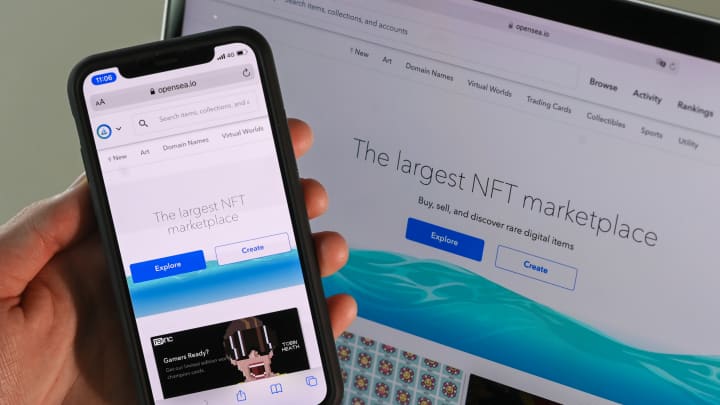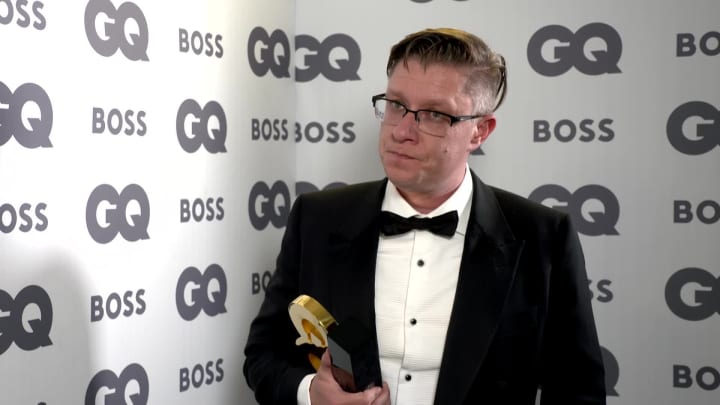17/09/2021 OpenSea, amid insider trading controversy, rolls out NFT marketplace app

A smartphone and a screen show the website OpenSea, where digital artworks are sold using NFT. NFTs, non-fungible tokens, are unique cryptographic credentials that are written to the blockchain attached to a file (image, music, video).
picture alliance | picture alliance | Getty Images
The largest NFT marketplace, OpenSea, is launching an app for users in the Google Play and Apple App Store on this week.
The app rollout comes after a wildly busy month for the platform: in August, OpenSea's website saw two million transactions, totaling $3.4 billion in trading volume and tripling activity from July. So far in September, daily trading volume has dropped significantly from its peak in late August, according to Dune Analytics. Still, the app could build on the company's momentum, offering users a way to check non-fungible token holdings, sales, and trading histories easily on mobile. The app is expected to appear in app stores on Friday.
OpenSea's app launch follows news that one of the company's employees participated in an NFT insider trading scheme. The company, valued at $1.5 billion, admitted to the incident, and co-founder and CEO Devin Finzer tweeted an apology to users on Wednesday:
"We're conducting a thorough review of yesterday's incident and are committed to doing the right thing for OpenSea users."
In a statement to CNBC via email, Finzer wrote: "I was incredibly disappointed by the news and this behavior does not represent our values at OpenSea. We are working with an outside law firm to conduct an internal review."
So far, the company has garnered financial backing from big names in the crypto community, including Coinbase Ventures, Blockchain Capital, and Mark Cuban. At only four years old, OpenSea hit unicorn status with its latest funding round led by Andreessen Horowitz's a16z, with participation from Coatue, Ashton Kutcher, and Shopify CEO Tobi Lutke.
OpenSea is riding the current wave of interest in non-fungible tokens — unique, collectible digital assets built on the blockchain. Flashy transactions like the $69 million Beeple sale at Christie's have captured the mainstream's attention, but for co-founders Finzer and Alex Atallah, as well as others in the space, the excitement resides in what's still possible. "We are bringing a new technology to a mainstream audience," Finzer told CNBC. The company is focused on bringing consumers an experience that's "quick, easy, and really fun at the end of the day."
Sound familiar? Brokerage app Robinhood began with similar hopes of bringing a seemingly insular and highly guarded world to the masses, and in part, Finzer is comfortable with that comparison. Both OpenSea and Robinhood recognize that a smooth consumer experience is key to platforms operating in worlds that seem complicated to outsiders. The products are different, though: OpenSea, Finzer stressed, is a marketplace. OpenSea's website currently offers a place to buy, sell, explore, and show off NFT collections, and the app will feature integrations with social media and a feature to "follow" other users.

Harvard Business School associate professor Scott Duke Kominers emphasized consumer ease as a tenet of success for platforms in the NFT space. "A lot of the most successful players are the ones that have submerged some of the crypto-ness of the system in ways that make the experience for the consumer feel more like a normal online purchasing experience," Kominers told CNBC.
OpenSea competitors include Nifty Gateway, FTX, and Mintable.
NFTs were originally touted as a way to support artists, and entrepreneurs like Gary Vaynerchuk have since seized digital collectibles as opportunities for branding, marketing, and advertising.
"It's all of the above," Finzer said. "It's a brand new paradigm shift of the internet."
Ticketing and gaming, as well as the art industry, could each find a home in the metaverse.
Barriers to entry in the NFT space remain high, according to Kominers. Significant costs plus a long chain of mechanics are just two challenges for the industry players. Right now, aspiring NFT collectors must first open an account on a cryptocurrency exchange, open at least one crypto wallet, send money to a crypto exchange account, send that to the wallet, connect the wallet to the appropriate platform, pay a "gas fee" for the computing power that the transaction takes on the blockchain, and finally, buy the NFT in question, incurring yet another fee and risking transaction failure. The sheer length of the logistical process is enough to turn hesitant consumers off.
Environmental impact is another sticking point for critics, who point to bitcoin's carbon footprint. According to Digiconomist, the carbon footprint for ethereum, the blockchain favored by the NFT space, is comparable to that of Denmark. Ethereum relies on a "proof of work" system that requires a large amount of processing power, but OpenSea co-founder and CTO Atallah points to the company's recent transition to the "proof of stake" polygon blockchain as one way to combat the metaverse's drain on energy resources.
Kominers says there is plenty of risk for early leaders in the space. The first players in an industry aren't necessarily the most successful — take Vine and Tiktok, as an example. "Your network has to be powerful enough to overcome competitors who later borrow the successful parts of your business model and target a slightly different audience."
Still, he says total engagement is understated, which means NFTs, OpenSea, and its competitors, may still have room to run.
 (0)
(0)
 (0)
(0)
https://www.cnbc.com/amp/2021/09/16/opensea-amid-insider-trading-controversy-rolls-out-nft-app.html
